The stresses of physical exertion often are
complicated by environmental thermal conditions. Performing in extreme heat or
cold places a heavy burden on the mechanisms that regulate body temperature.
Although these mechanisms are amazingly effective in regulating body
temperature under normal conditions, mechanisms of thermoregulation can be inadequate when we are subjected to extreme
heat or cold. Fortunately, our bodies are able to adapt to such environmental
stresses with continued exposure over time, a process known as acclimation(which refers to a
short-term adaptation, e.g. days to weeks) or acclimatization(the proper term when we are referring to
adaptations gained over long periods of time, e.g. months to years).
Body temperature regulation
Humans are homeothermic, which means that
internal body temperature is physiologically regulated to keep it nearly
constant even when environmental temperature changes. Although a person’s
temperature varies from day to day, and even from hour to hour, these fluctuations
are usually no more than about 1.0 °C(1.8 °F). Only during prolonged heavy
exercise, fever due to illness, or extreme conditions of heat or cold do body
temperatures deviate from the normal range of 36.1 to 37.8 °C(97.0 – 100.0 °F).
Body temperatures reflects a careful balance between heat production and heat
loss. Whenever this balance is disturbed, body temperature changes.
Metabolic heat production
Only a small part(usually less than 25%) of the
energy(adenosine triphosphate – ATP)
the body produces is used for physiological functions such as muscle
contraction: the rest is converted to heat. All active tissues produce
metabolic heat(M) that must be intricately offset by heat loss to the
environment to maintain the internal temperature of the body. If the body’s
heat production exceeds its heat loss, as it often does during moderate- to
heavy-intensity aerobic activity, the internal temperature increases. People’s
ability to maintain a constant internal temperature depends on their ability to
balance the metabolic heat they produce and the heat they gain from the
environment with the heat their body loses.
Transfer of body heat to and from the environment
For the body to transfer heat to the
environment, the heat produced in the body must move from deep in the body(the
core) to the skin(the shell), where it has access to the outside environment.
The heat is moved from the core to the skin by the blood. Only when heat reaches the skin can it be transferred to the
environment by any of four mechanisms: conduction, convection, radiation and
evaporation.
Conduction
and convection
Heat
conduction(K) involves the transfer of heat from one solid material to
another through direct molecular contact. As an example, heat can be lost from
the body when the skin is in contact with a cold object, as when one sits on
cold metal bleachers at a ball game. Conversely, if a hot object is pressed
against the skin, heat from the object will be conducted to the skin, warming
it. If the contact is prolonged, heat from the skin surface can be transferred
to the core, raising internal(core) temperature. During exercise, conduction is
usually negligible as a source of heat exchange because the body surface area
in contact with solid objects(for example, soles of the feet on hot playing
fields) is small.
Convection(C), on the other hand, involves moving heat from
one place to another by the motion of a gas or a liquid across the heated
surface. Although we’re not always aware of it, the air around us is is constant
motion. As it circulates around us, passing over the skin, heat is exchanged
with the air molecules. The greater the movement of the air(the liquid, such as
water), the greater the rate of heat exchange by convection. Thus, in an
environment that is cooler than the skin temperature, convection permits the
transfer of heat from the skin to the air(heat loss); however, if air
temperature is higher than skin temperature, heat is gained by the body through
convection. We often consider these processes to be mechanisms of heat loss,
forgetting that when the environmental temperature exceeds skin temperature,
the gradient works in the opposite direction.
Convection constantly removes metabolically
generated heat from the body when the air temperature is lower than the skin
temperature. However, if a person is submerged in cold water, the amount of
heat dissipated from the body to the water by convection can be nearly 26 times
greater than when the person is exposed to a similar cold air temperature.
Radiation
In a body at rest, radiation(R) is the primary method of the discharging the resting
body’s excess heat. At normal room temperature(typically 21-25 °C, or 69.8-77
°F), the nude body losses about 60% of its excess heat by radiation. The heat
is given off in the form of infrared rays, which are a type of electromagnetic
wave. Figure below shows two infrared thermograms of an individual.
The skin constantly radiates heat in all
directions to objects around it, such as clothing, furniture, and walls,
objects that are warmer. If the temperature of the surrounding objects is
greater than that of the skin, the body will experience a net heat gain via
radiation. A tremendous amount of radiant heat is received from exposure to the
sun.
Taken together, conduction, convection, and
radiation are considered avenues of dry
heat exchange. Resistance
to dry heat exchange is called insulation,
a concept known to everyone as it relates to clothing and home heating and
cooling. The ideal insulator is a layer of still air(remember that moving air
causes convective heat loss), which we achieve by trapping layers of air in
fibers(down, fiberglass, etc.). Adding insulation in this way minimizes
unwanted heat loss in cold environments. However, during exercise scenarios we
want to dissipate heat to the environment, which is best accomplished by
wearing light-colored clothing(to limit radiant heat absorption) that allows
for maximally exposed skin surface area.
Evaporation
Evaporation(E) is the primary for heat dissipation during exercise.
As a fluid evaporates, heat is lost. Evaporation accounts for about 80% of the
total heat loss when one is physically active and is therefore an extremely
important avenue for heat loss. Even at rest, evaporation accounts for 10% to
20% of body heat loss, since some evaporation accounts for 10% to 20% of body
heat loss, since some evaporation occurs without our awareness(insensible water
loss).
As body core temperature increases, sweat
production increases. As sweat reaches the skin, it is converted from a liquid
to a vapor, and heat is lost from the skin in the process. Thus, sweat
evaporation becomes increasingly important as body temperature increases.
Evaporation of 1L of sweat in an hour results
in the loss of 680W(2,428kJ) of heat. An important concept to remember is that
sweat must evaporate for any heat loss to occur. Some sweat drips off the body
or stays on the skin or in the clothing. This nonevaporated sweat contributes
nothing to body cooling and simply represents a wasteful loss of body water.
Analogous to insulation, which limits dry heat
exchange, clothing adds resistance to sweat evaporation. While some cooling of
the skin does occur as sweat evaporates from wet clothing surfaces, the cooling
power is less than for evaporation directly from skin to air. Clothing that
fits loosely and comprises fabrics that promote wicking or free movement of
water vapor molecules through the fabric enhance evaporative cooling.
Figure below shows the complex interaction
between the mechanisms of body heat balance(production and loss) and
environmental conditions. Using the symbols defined in the previous paragraphs,
we can represent the state of heat balance by a simple equation:
M – W ± R ± C ± K – E = 0,
where W represents any useful work being performed
as a result of muscle contraction. Notice that while R, C, and K can be either
positive(heat gain) or negative(heat loss), E can only be negative. When M – W
± R ± C ± K – E > 0, heat is stored in the body and core temperature rises.
Humidity and heat loss
The water vapor pressure of the air(the
pressure exerted by water vapor molecules suspended in the air) plays a major
role in evaporative heat loss. Relative humidity is a more commonly used term
that relates the water vapor pressure of the air that of fully saturated
air(100% humidity). When humidity is high, the air already contains many water
molecules. This decreases its capacity to accept more water because the vapor
pressure gradient between the skin and the air is decreased. Thus, high humidity
limits sweat evaporation and heat loss, while low humidity offers an ideal
opportunity for sweat evaporation and heat loss. But this efficient cooling
mechanism can also pose a problem. If sweating is prolonged without adequate
fluid replacement, dehydration can occur.
Thermoregulatory control of heat exchange
We live our entire lives within a very small,
fiercely protected range of internal body temperatures. If sweating and
evaporation were unlimited, we could withstand extreme ambient heat(e.g., even
oven temperatures >200°C for short periods!) if we were protected from
contact with hot surfaces. On the other hand, the temperature limits for living
cells range from about 0°C(where ice crystals form) to about 45°C(where
intracellular proteins start to unravel), and humans can tolerate internal temperatures below 35°C for
only brief periods of time. To maintain internal temperature within these
limits, we have developed very effective and, in some instances specialized,
physiological responses to heat and cold. These responses involve the finely
controlled coordination of several body systems.
Internal body temperature at rest is regulated
at approximately 37°C(98.6°F). During exercise, the body is often unable to
dissipate heat as rapidly as it is produced. In rare circumstances, a person
can develop an internal temperature exceeding 40°C(104°F), with a temperature
above 42°C(107.6°F) in active muscles. The muscles’ energy systems become more
chemically efficient with a small increase in muscle temperature, but internal
body temperatures above 40°C can adversely affect the nervous system and reduce
further efforts to unload excess heat. How does the body regulate its internal
temperature? The hypothalamus plays a central role.
The
preoptic-anterior hypothalamus: the body’s thermostat
A simple way to envision the mechanisms that
control internal body temperature is to compare them to the thermostat that
controls the air temperature in a home, although the body’s mechanisms function
in a more complex manner and generally with greater precision than a home
heating and cooling system. Sensory receptors called thermoreceptors detect changes in temperature and relay this
information to the body’s thermostat, located in a region of the brain called the preoptic-anterior hypothalamus(POAH). In
response, the hypothalamus activates mechanisms that regulate the heating or
cooling of the body. Like a home thermostat, the hypothalamus has a
predetermined temperature, or set point, that it tries to maintain. This is the
normal body temperature. The smallest deviation from this set point signals
this thermoregulatory center to readjust the body temperature.
Thermoreceptors are located throughout the body
but especially in the skin and central nervous system. The peripheral receptors located in the skin monitor the
skin temperature, which varies with changes in the temperature around a person.
They provide information not only to the POAH but also to the cerebral cortex,
which allows one to consciously perceive temperature and voluntarily control
one’s exposure to heat or cold. Because the skin temperature changes long
before core temperature, these receptors serve as an early warning system for
impeding thermal challenges.
Central receptors are located in the hypothalamus,
other brain regions, and the spinal cord and monitor the temperature of the blood as it circulates through sensitive
areas. These central receptors are responsive to blood temperature changes as
small as 0.01°C(0.018°F). Because of this exquisite sensitivity, very small
changes in the temperature of the blood passing through the hypothalamus
quickly trigger reflexes that help one conserve or eliminate body heat as
needed.
Effectors
that alter body temperature
When body temperature fluctuates, the normal
temperature usually can be restored by the actions of four sets of effectors:
- Skin arterioles. When skin or core temperature changes,
the POAH sends signals via the sympathetic nervous system(SNS) to the
smooth muscle in the walls of the arterioles that supply the skin, causing
them to dilate or constrict. This either increases or decreases skin blood
flow. Skin vasoconstriction results primarily from SNS release of the
neurotransmitter norepinephrine,
although other neurotransmitters are involved as well, and facilitates
heat conservation by minimizing dry heat exchange. Skin vasodilation in
response to heat stress is a more complex and less well understood
process. Increased skin blood flow aids in heat dissipation to the
environment through conduction, convection, and radiation(and indirectly,
evaporation as skin temperature goes up).
Fine-tuning of skin blood flow is the mechanism by which minute-to-minute
adjustments are made in heat balance and exchange. These adjustment are
rapid and occur with no real energy cost to the body.
- Eccrine sweat glands. When either the skin or core temperature
is elevated sufficiently, the POAH also sends impulses through the SNS to
the eccrine sweat glands,
resulting in active secretion of sweat onto the skin surface. The primary
neurotransmitter involved is acetylcholine;
thus we refer to sweat gland activation as sympathetic cholinergic
stimulation. Like skin arterioles, sweat glands are about 10 times more
responsive to increases in core temperature than to similar increases in
skin temperature. The evaporation of this moisture removes heat from the
skin surface.
- Skeletal muscle. Skeletal muscle is called into action
when a person needs to generate more body heat. In a cold environment,
thermoreceptors in the skin sense cold and send signals to the
hypothalamus. Similarly, whenever the blood temperature decreases, the
change is sensed by central thermoreceptors. In response to this combined
neural input, the hypothalamus activates the brain centers that control
muscle tone. These centers stimulate shivering, which is a rapid,
involuntary cycle of contraction and relaxation of skeletal muscles. This
increased muscle activity is ideal for generating heat to either maintain
or increase the body temperature, because no useful work results from the
shivering, only heat production.
- Endocrine glands. The effects of several hormones cause the
cells to increase their metabolic rates. Increased metabolism affects heat
balance because it increases heat production. Cooling the body stimulates
the release of thyroxine from the thyroid gland. Thyroxine can elevate the metabolic rate throughout the body by
more than 100%. Also, recall that epinephrine and norepinephrine(the catecholamines) mimic and enhance
the activity of the SNS. Thus, they directly affect the metabolic rate of
virtually all body cells.




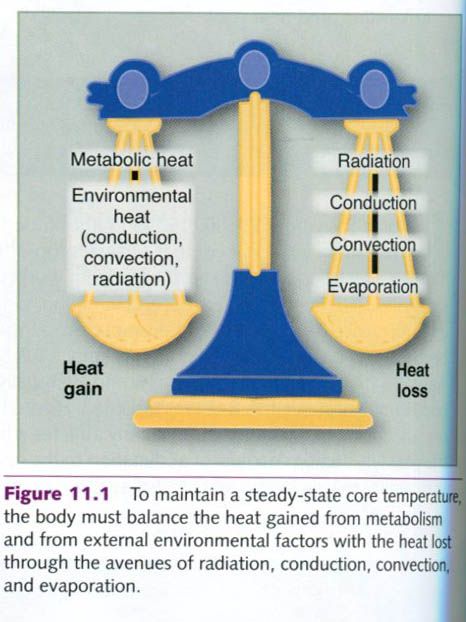
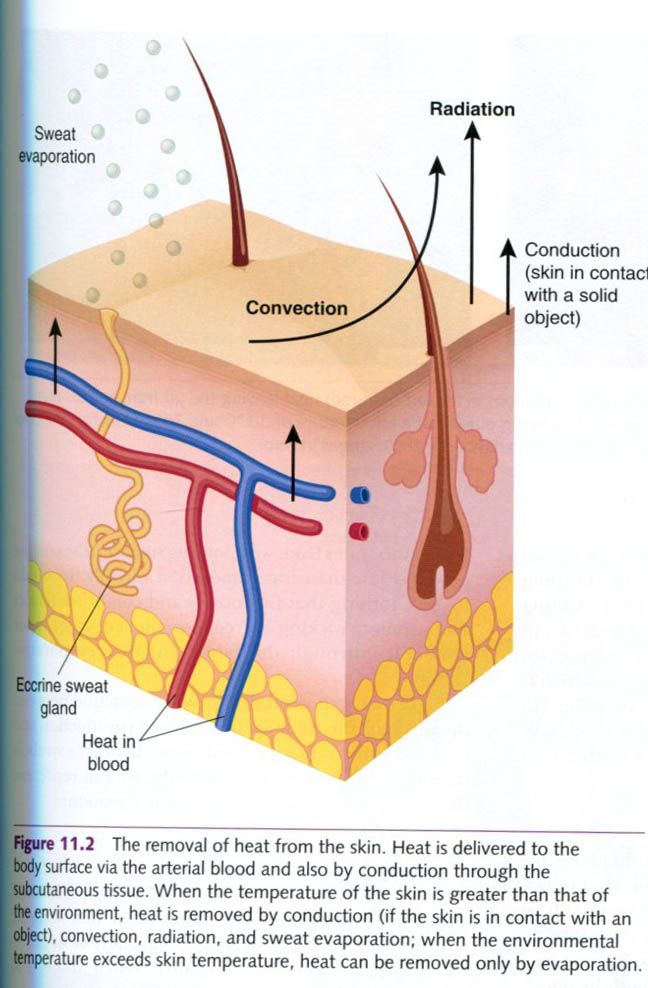
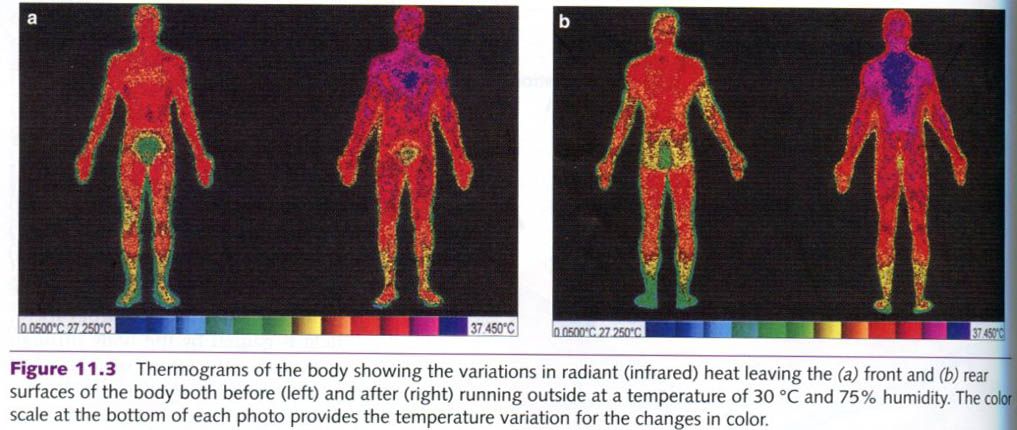

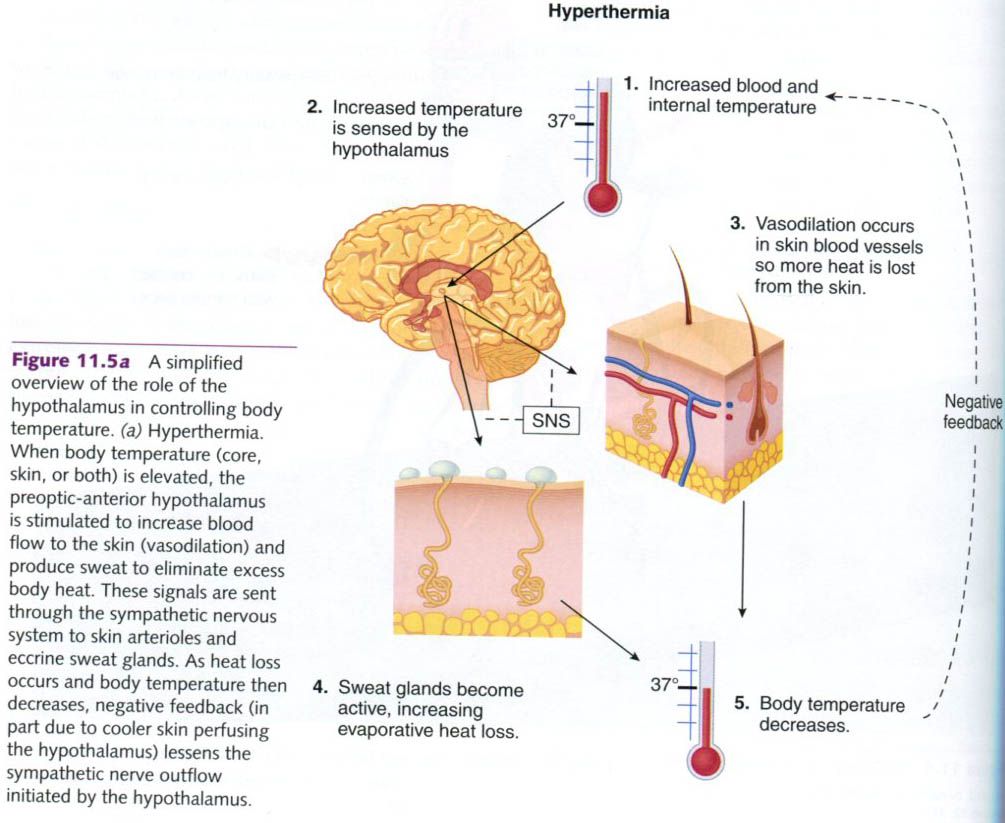
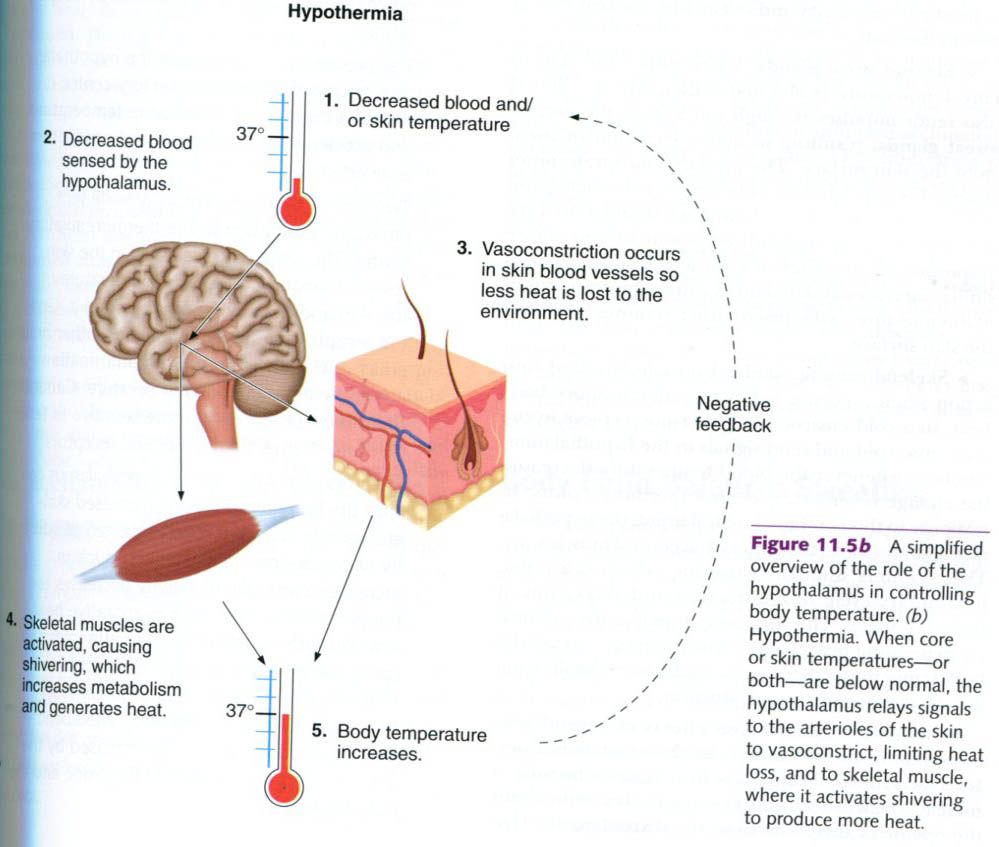





0 коментара:
Постави коментар